

Ian Fraser: The beauty and insanity of HFT. By Ian Fraser, a financial journalist who blogs at his web site and at qfinance .

His Twitter is @ian_fraser . What has become of our markets? Nanex, the market analysis firm, has animated a half second of trading activity in Johnson & Johnson stock. Dark Pools: High-Speed Traders, A.I. Bandits, and the Threat to the Global Financial System. Scott Patterson’s Dark Pools: High-Speed Traders, A.I.

Bandits, and the Threat to the Global Financial System is as insider view of the world of Algos, HFT, and software driven markets. Patterson does a great job of taking a dark, highly complex subject as the basis for a compelling, character driven narrative. Inside the Black Box / the Alchemists of Wall street – a look into the world of High Frequency trading. Quant trading: How mathematicians rule the markets. 26 September 2011Last updated at 00:22 By Richard Anderson Business reporter, BBC News Mathematicians and their trading programs are increasingly taking the place of professional investors in financial centres across the world.
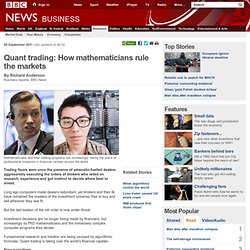
Quants: The Alchemists of Wall Street (Marije Meerman, VPRO Backlight 2010) Algorithms Take Control of Wall Street. Today Wall Street is ruled by thousands of little algorithms, and they've created a new market—volatile, unpredictable, and impossible for humans to comprehend.Photo: Mauricio Alejo Last spring, Dow Jones launched a new service called Lexicon, which sends real-time financial news to professional investors.
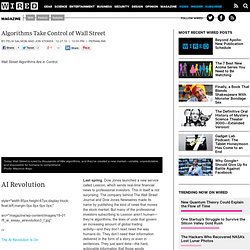
This in itself is not surprising. The company behind The Wall Street Journal and Dow Jones Newswires made its name by publishing the kind of news that moves the stock market. But many of the professional investors subscribing to Lexicon aren’t human—they’re algorithms, the lines of code that govern an increasing amount of global trading activity—and they don’t read news the way humans do.
They don’t need their information delivered in the form of a story or even in sentences. Lexicon packages the news in a way that its robo-clients can understand. An app that jams with you. A good session player is hard to find, but ujam is always ready to rock. LRB · Donald MacKenzie · How to Make Money in Microseconds. What goes on in stock markets appears quite different when viewed on different timescales.

Look at a whole day’s trading, and market participants can usually tell you a plausible story about how the arrival of news has changed traders’ perceptions of the prospects for a company or the entire economy and pushed share prices up or down. Look at trading activity on a scale of milliseconds, however, and things seem quite different. When two American financial economists, Joel Hasbrouck and Gideon Saar, did this a couple of years ago, they found strange periodicities and spasms. Lessons From The Flash Crash - Intelligent Investing - Ideas from Forbes Investor Team. The Matrix, but with money: the world of high-speed trading - Ar.
It’s Time for a Tax to Kill High Frequency Trading. It’s frustrating to know that there’s a simple solution to a serious problem but no one seems willing to do the obvious.
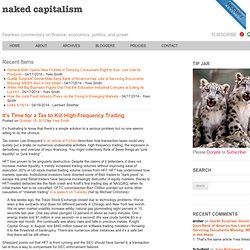
Tax maven Lee Sheppard in an article at Forbes describes how transaction taxes could very quickly put a brake on numerous undesirable activities: high frequency trading, the explosion in derivatives, and overuse of repo financing. You might collectively think of these things as “junk liquidity” or “junk trading”. HFT has proven to be singularly destructive. Despite the claims of it defenders, it does not increase market liquidity; it merely increases trading volumes without improving ease of execution. 60% of US stock market trading volume comes from HFT.
HFT has undermined how markets operate. A few weeks ago, the Tokyo Stock Exchange closed due to technology problems. Risk from High Frequency and Algorithmic Trading Not as Big as Many Think. Skynet begins to learn, at a geometric rate.It becomes self-aware at 2:14 a.m. eastern time, August 29.In a panic, they try to pull the plug.-- Terminator 2 There is a general view that one way or another the end result of all the high frequency and algorithmic trading will be a blowup. But I don’t think the risk is as big as many are making it out to be. First, let me point out the difference between high frequency trading and algorithmic trading. Both execute using computers, and since computers work really fast, both can be accused of whatever sins are embodied in millisecond trading. High-Frequency Firms Triple Trades in Rout. The stock market’s fastest electronic firms boosted trading threefold during the rout that erased $2.2 trillion from U.S. equity values, stepping up strategies that profit from volatility, according to one of their biggest brokers.
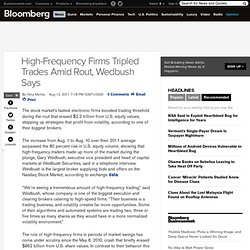
The increase from Aug. 1 to Aug. 10 over their 2011 average surpassed the 80 percent rise in U.S. equity volume, showing that high-frequency traders made up more of the market during the plunge, Gary Wedbush, executive vice president and head of capital markets at Wedbush Securities, said in a telephone interview. Wedbush is the largest broker supplying bids and offers on the Nasdaq Stock Market, according to exchange data. “We’re seeing a tremendous amount of high-frequency trading,” said Wedbush, whose company is one of the biggest execution and clearing brokers catering to high-speed firms. “Their business is a trading business, and volatility creates far more opportunities. Rising Volume Rapid Orders Regulatory Probe Adding Liquidity. The problem with high frequency trading. Last night, on BBC Radio 3, I was featured reading an essay about high frequency trading.

I hope it’s fun to listen to, but if you want to read it, here you go. One of the many consequences of global warming is that it’s now, for the first time, possible to drill under the sea bed of the Arctic ocean. The oil companies are all there, of course, running geological tests and bickering with each other about the potential environmental consequences of an oil spill.
Broken Markets: How High Frequency Trading and Predatory Practices on Wall Street are Destroying Investor Confidence and Your Portfolio. High-Frequency Trading Prospers at Expense of Everyone. Finally, a bit of evidence, rather than anecdote, about the costs of high-frequency trading.

In a new study, Andrei Kirilenko, the chief economist at the U.S. Commodity Futures Trading Commission, along with researchers at Princeton University and the University of Washington, examined high-frequency trading in a futures contract called the e-mini S&P 500, between August 2010 and August 2012. The study looked at only the expiring contracts (which trade electronically on the Chicago Mercantile Exchange) that are used to bet on the direction of the Standard & Poor’s 500 Index. The researchers also did something they’d never been able to do before: Use actual trading data from individual firms, though none were identified.
What that data does is help explain the frenzy in today’s markets: The most aggressive firms tend to earn the biggest profits, hence the incentive to trade as quickly and as often as possible. Big Puzzle A big puzzle, though, is why these small investors lost at all. HFT-Bibliography. HFT Has Disconnected Commodities From Fundamentals. High-frequency traders have caused U.S. commodity futures prices to disconnect from market fundamentals of supply and demand since the 2008 financial crisis.
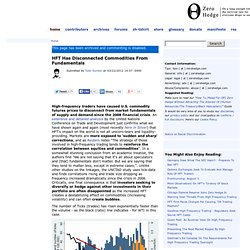
An extensive and detailed analysis by the United Nations Conference on Trade and Development just confirms what we have shown again and again (most recently here in Silver) that HFT's impact on the world is not all unicorn-tears and liquidity-providing. Markets are more exposed to 'sudden and sharp' corrections, and as Reuters notes "The strategy of those involved in high-frequency trading tends to reinforce the correlation between equities and commodities". In a somewhat stunning conclusion from an academic treatise, the authors find "We are not saying that it's all about speculators and (that) fundamentals don't matter.
But we are saying that they tend to matter less, except in extreme cases,". MPRA Paper 37486. Goodbye High Frequency Trading - Regulators Seek Secret HFT Codes. The crusade against High Frequency Trading which Zero Hedge started well over two years ago, is now coming to an end. Rise of the Algorithm. Age of the Algorithm.
Content farms depend heavily on search engines for traffic. Photograph by Marc Rimmer. SOUTH BEND, Ind. —Tony Bucciferro put the Michigan State Spartans on his back Sunday and spurred them to a 3–0 win over the Notre Dame Fighting Irish (7–11) at Frank Eck Stadium.Bucciferro kept the Fighting Irish off the board during his nine innings of work for Michigan State (12–4). He struck out five and allowed one walk and three hits. This generic piece of sports reporting is remarkable for only one reason: a computer algorithm wrote it. Simply put, an algorithm is a series of instructions that, if properly followed, can lead to the solution of a problem.
As computers have become faster and more powerful—and as the costs of storage and bandwidth have plummeted—there is virtually no limit to the specificity, size and complexity of computer algorithms. Schapiro Questions Role of High-Frequency Traders. The Reign of Robots Is Closer Than You Think: Buchanan. The futurist Ray Kurzweil has famously predicted that humanity is approaching a “singularity,” a fateful moment when our technology becomes smarter than us and able to learn faster than we can, when it becomes the principal creator of new technologies and machines race far ahead of us.
Humans may effectively fall out of the loop -- a species demoted, if not eliminated. For now, this world remains science fiction, at least at the level of humanity. But finance is flirting with a similar transition, as ever-faster computing and communications technology takes high-frequency trading into a regime of speed where human beings can no longer keep up.
In fact, we may have already arrived. Nanosecond Trading Could Make Markets Go Haywire. The afternoon of May 6, 2010 was among the strangest in economic history. Starting at 2:42 p.m. EDT, the Dow Jones stock index fell 600 points in just 6 minutes. Its nadir represented the deepest single-day decline in that market’s 114-year history. Dave Lauer: It Ain't Rocket Surgery: The Skewed Incentives and Dangerous Consequences of High-Frequency Trading.